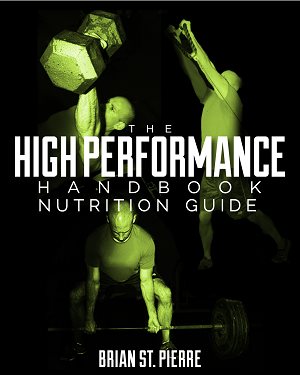What Are People Saying About The High Performance Handbook Nutrition Guide?
Filed under: General Health, Nutrition, Training
With the release of the High Performance Handbook Nutrition Guide just 2 days ago, the positive feedback is already rolling in!
Just this morning, Shane made this comment on my most recent post:
“The nutrition section was great! Pretty much worth the price of the entire bundle on its own
Found some of the lesser-known stuff (like the section on beer) fascinating.”
With that in mind, you might be wondering what else you will learn if you pick up your own copy of The High Performance Handbook (besides the finer details of beer!)? Well here are a few excerpts from the Nutrition Explanation Section of the book to give you a small taste of the more than 200 pages of content I provide:

Dairy and Diabetes Risk
With little fanfare, a study recently came out by Dr. Dariush Mozaffarian and colleagues. Why so little fanfare, you ask? It’s because the study suggests that dairy fat may actually protect against diabetes, and that goes against conventional wisdom and government recommendations.
Dr. Mozaffarian and company collected two measures of dairy fat intake in 3,736 Americans. They took six 24-hour dietary recall questionnaires, as well as assessing blood levels of trans-palmitoleate. Trans-palmitoleate comes almost exclusively from dairy fat and red meat fat, and therefore it reflects the intakes of these foods. Dairy provided most of the trans-palmitoleate fatty acid in this study.
Adjustments were made for confounding factors, and trans-palmitoleate levels were associated with a smaller waist circumference, higher HDL cholesterol, lower serum triglycerides, lower C-reactive protein (a marker of inflammation), lower fasting insulin and lower calculated insulin resistance. In addition, people who had the highest levels of trans-palmitoleate had 1/3 the risk of developing diabetes over the 3-year study period.
Again, it is important to note that trans-palmitoleate is a fatty acid, and so is only provided in significant amounts by whole fat dairy, not from low-fat or fat-free versions. The investigators also noted that “greater whole-fat dairy consumption was associated with lower risk for diabetes.” This is an important distinction, as it wasn’t just trans-palmitoleate levels that were associated with the decreased risk, but the actual consumption of whole-fat dairy itself that seemingly provides the benefit.
Here’s another nice quote from the authors: “Our findings support potential metabolic benefits of dairy consumption and suggest that trans-palmitoleate may mediate these effects. They also suggest that efforts to promote exclusive consumption of low-fat and non-fat dairy products, which would lower population exposure to trans-palmitoleate, may be premature until the mediators of the health effects of dairy consumption are better established.”
While it is certainly possible that trans-palmitoleate is mediating a lot of these positive health outcomes that were associated with it, in all reality, it only makes up a tiny fraction of the fat content of milk. I tend to believe that instead, it is more of a marker of dairy fat intake, with the benefits more likely coming from the other elements contained in dairy fat – CLA, vitamin K2, butyric acid, vitamin D – in addition to the trans-palmitoleate.

The Importance of Particle Number
Moving beyond particle size, there is emerging research that the number one risk factor for cardiovascular disease is actually particle number, in particular the number of LDL particles you have. This research even seems to indicate that even if you have large and fluffy LDL, if you have too many of them, you are at an increased risk of heart disease.
You might be wondering, “Why?” The full details are beyond the scope of this piece, but basically, it is a probabilities game. The more particles you have (not the amount of cholesterol in the particles, and maybe not even the size of the particles), the more likely the chance that one of those LDL particles is going to penetrate into your arteries, beginning the whole atherosclerosis cascade that will eventually lead to heart disease.
Interestingly, this research shows that when particle numbers are taken into account, particle size no longer has a significant relationship with atherosclerosis. So, while some earlier research showed large and fluffy particles to be more benign, this may not necessarily be true. However, this research does seem to indicate that while those small and dense LDL particles may not be any more atherogenic, they are actually a marker for metabolic dysfunction, inflammation and insulin resistance, so they are still not a good thing.
To actually know the amount of LDL particles you have, you need to have an advanced blood lipid panel done. Not all of these panels show LDL particle number (LDL-P), but they will all likely show your apo-B number, which can be used as a proxy for LDL-P.
Unfortunately, you can have low LDL-C with high LDL-P (and therefore a high risk of heart disease), and low LDL-P with high LDL-C (and therefore a low risk of heart disease). They do not necessarily go hand-in-hand. So, you can have high LDL-C and be at low risk, and have low LDL-C and be at high risk. This is not what most doctors will believe, so you might have to show them the research referenced at the end of this book!
In fact, the research also seems to indicate that people with high LDL-P and low LDL-C are actually at the highest risk for heart disease and overall mortality. This risk is even higher than in people with high levels of each. This is because people with high LDL-P and low LDL-C tend to have small and dense LDL particles, which while possibly not a direct cause of heart disease, are at least a marker for metabolic dysfunction that further decreases health.
Intrigued?
Pick up your copy of The High Performance Handbook Gold Package and you get my Nutrition Guide in conjunction with Eric’s incredible resource, which is a truly unique training program and like nothing you have ever seen before…
First, unlike your typical cookie-cutter program, it doesn’t force you to do an exercise you can’t.
Second, it designs a program suitable to your needs – based on how you move, what your schedule allows, and what your goals are.
Third, it’s an entire system. Not just some manual that says “do this.” We give you an entire video database, how to modify exercises, and much more.
Check out the BSP Training & Nutrition Newsletter!
You will get immediate access to:
- Weekly updates and exclusive content.
- The 20-page report "The Truth About Saturated Fat & Cholesterol."
- Become more awesome!
Posted on October 24th, 2013 by Brian St. Pierre
3 Comments




December 20th, 2013 at 1:44 am
My spouse and I absolutely love your blog and find the majority
of your post’s to be just what I’m looking for. can you offer
guest writers to write content available for you? I wouldn’t mind composing a post or elaborating on some of the subjects you
write with regards to here. Again, awesome web log!
July 10th, 2014 at 1:22 pm
Thanks for finally writing about > The Home of BSP Training & Nutrition Blog Archive What Are People Saying About The High Performance Handbook Nutrition Guide?
< Liked it!
My blog seo barnet (needlessworker3767465.pen.io)
August 21st, 2014 at 11:26 am
I got this web site from my friend who informed me about this website
and now this time I am visiting this website and reading very informative articles or reviews here.